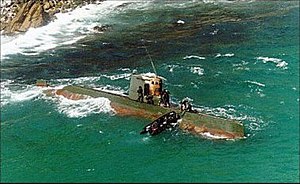This article needs additional citations for verification. (August 2010) |
 Submarine involved in the 1996 incident
| |
| Class overview | |
|---|---|
| Builders | Bong Dao Bo Shipyards, Singpo[1] |
| Operators | |
| Preceded by | Yugo class |
| Succeeded by | Sinpo class |
| Subclasses | Attack version, infiltration/reconnaissance version |
| In commission | 1991 |
| Completed | 41+ |
| Active | 40 (February 2021)[2][3] |
| Lost | 1 captured by South Korea |
| Preserved | 1 |
| General characteristics (Sang-O I armed version) | |
| Type | Coastal submarine |
| Displacement |
|
| Length | 34 m (111 ft 7 in) |
| Beam | 3.8 m (12 ft 6 in) |
| Propulsion | Diesel-electric: 1 small diesel, 1 electric motor, 1 shaft |
| Speed |
|
| Range | 1,500 nmi (2,800 km; 1,700 mi) |
| Test depth | 150 m (490 ft), capable of bottoming |
| Capacity | 0 (10/11 in recce version) |
| Complement | 15 |
| Sensors and processing systems |
|
| Armament |
|
| Notes | Fitted with a snorkel |
The Sang-O ("Shark") class of submarines (Hangul: 상어급 잠수함) are diesel-electric coastal submarines in service with the Korean People's Navy, the navy of North Korea.[4] They are the country's second largest indigenously-built submarines.
Though North Korean military capabilities are mostly kept classified, it was reported that North Korea maintains 40 Sang-O-class submarines as of February 2021.[3]
- ^ Miller 2003, p. 472.
- ^ "N.Korea Builds up Submarine Force" (PDF). The Chosun Ilbo. 21 March 2011.
- ^ a b "North Korea Submarine Capabilities | NTI".
- ^ "SSC Sang-o Class". GlobalSecurity.org.